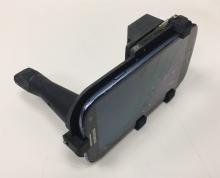DALLAS – A low-cost , in a clinical study of 92 people.
“Oral cancer is the sixth most common cancer in the world, but it’s the only major cancer whose outcome has not improved in the last 50 years,” study author Petra Wilder-Smith DDS, PhD, said in an interview following the annual conference of the American Society for Laser Medicine and Surgery Inc. “The main challenge is that over two-thirds of oral cancers are detected after they’ve metastasized. When you get spread like that, your survival is about 20% at 5 years, whereas if you detect it before spread, your survival is about 80% at 5 years.”
Dr. Wilder-Smith, professor and director of dentistry at the University of California, Irvine, pointed out that oral cancer primarily affects the medically underserved. “That ties in with the second challenge, which is that oral cancer is really hard to diagnose and monitor visually with the naked eye,” she said. “I’m reasonably good at it because I’ve been doing it for 30 years, but everyone still needs to biopsy their patients to diagnose them and to monitor them. It’s important, because a high proportion of the population have lesions that may become malignant in the mouth. We are unable to predict which lesions, in whom, and when. That’s why we have a huge problem.”At the meeting, Vania Firmalino, an undergraduate student at the University of California, Irvine, discussed efforts by Dr. Wilder-Smith, Rongguang Liang, PhD, of the College of Optical Sciences at the University of Arizona, Tucson, and their colleagues to develop and evaluate the screening performance of a novel, low-cost smartphone-based mini probe for oral cancer screening and oral potentially premalignant lesions (OPMLs). The device provides high-resolution polarized white light images in combination with autofluorescence (AF) imaging capability.
The researchers recruited 92 people with visually healthy oral mucosa or oral leukoplakia, erythroplakia, or ulceration. Polarized white light and AF, as well as standard photographic images, were recorded of eight standard locations in the oral cavity of each patient. Each of these locations was separately diagnosed per usual standard of care by a blinded clinician. By evaluating a total of 32 variables from the polarized white light and AF images, characteristic signatures and cutoffs were determined for healthy mucosa, OPMLs, and oral cancer at each of the standard locations.The researchers found that inter-subject variation at each location was small, but inter-site differences were considerable. For example, optical data from OPMLs and oral cancer sites differed from normal with regard to white-light reflectance intensities, vascular homogeneity, and standard deviation. The AF signal in OPMLs and oral cancers shifted progressively to the red, together with a diminished green fluorescence signal. The cloud-based diagnostic algorithm based on these properties performed well, with an agreement with standard-of-care diagnosis of 80.6%.
“Artificial intelligence improves with data,” said Dr. Wilder-Smith, who is also a senior fellow at the university’s Chao Family Comprehensive Cancer Center. “We trained this system on about 200 images. When you’re up to 1,000 images per condition, that’s when you really start to get the benefits of artificial intelligence and machine learning. There’s huge potential here, especially when you think that 40% of the world’s risk for oral cancer is in India, which has good cell phone coverage. India also has a government-financed public health program whereby they already send health care workers to the remote areas of India to screen for basic diseases.”



